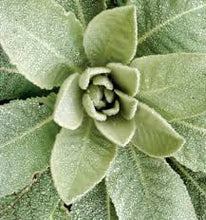Mullein is becoming increasingly well known for its antiviral and antibacterial properties. Unlike the other medicinal herbs described (with the exception of milk thistle), it is not a perennial but a biennial, flowering in its second year. But it can readily self-sow.
First-year plants form a rosette of soft velvety leaves that are up to a foot long. In the second year, the flower stalk grows up to an impressive 8 feet tall, with alternate leaves clasping the stem. Throughout the summer, yellow flowers bloom randomly in a dense terminal cluster.
Mullein is a common wild plant in temperate climates around the world that does well in arid areas. It grows easily from seed but transplants poorly. Simply scatter the tiny seeds in ordinary well-drained soil and rogue out some of the plants after a month or so. Thin to at least a foot apart. A location in full sun is preferable. In the second year, the mature plants will provide a stately vertical element best placed at the back of the garden. Because mullein self-sows readily, it can become a perennial feature if you allow it to do so.
To save seeds, simply cut spent stalks and shake them upside down into a bucket. After allowing insects to flee, clean the tiny seeds by passing them through ordinary window screen.
Mullein leaves are wonderfully soft to the touch; it seems very appropriate that they have such a gentle soothing effect internally as well. Mullein tea and mullein tinctures are traditional treatments for respiratory problems such as chest colds, mucous congestion, coughs, bronchitis and asthma. Both leaves and flowers contain mucilage that is calming and healing to irritated membranes.
Mullein oil is effective in destroying disease germs and is especially well known as a remedy for earache and ear discharge. It is also often recommended for eczema and other skin conditions.
It is interesting that many of mullein’s traditional medicinal uses were similar in Europe and in North America. Besides using mullein to treat respiratory problems, some First Nation tribes also used it to treat bruises, tumours, rheumatic pains and hemorrhoids. Some even smoked the roots or dried leaves to relieve throat conditions.




